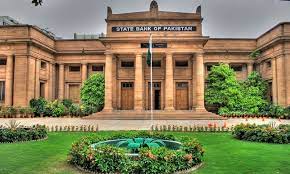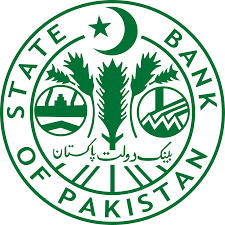The State Bank of Pakistan (SBP), established in 1948, assumes the pivotal role of the central bank in Pakistan, entrusted with the task of regulating and supervising the country’s monetary and banking system. Additionally, the SBP actively promotes economic growth by implementing policies that support investment, entrepreneurship, and productivity enhancement. Safeguarding financial stability is another key mandate of the SBP, as it strives to maintain the soundness and resilience of the banking sector and mitigate systemic risks. Through its diverse range of responsibilities, the SBP contributes significantly to the overall economic well-being and stability of Pakistan. Through its regulatory and supervisory functions, the SBP works diligently to ensure a sound and secure financial environment that contributes to the overall stability and prosperity of the country. State Bank of Pakistan Evolution Functions and Organization
| Established | 7 January 1948:75 years ago |
| Ownership | 100% state ownership |
| Governor | Jameel Ahmad |
| Headquarters | I. I. Chundrigar Road, Serai Quarter Karachi, Pakistan |
| Interest rate target | 19–21% |
| Interest on reserves | 19% |
| Currency | (PKR) Pakistani Rupee |
| Reserves | $3.814 billion (March 2023) |
| Reserve requirements | 4.00% |
| Bank rate | 20% |
| Website | www.sbp.org.pk |
Mission and Vision:
The State Bank of Pakistan (SBP) is driven by its mission to promote a strong and sustainable financial system while fostering a stable macroeconomic environment.
Through its actions and policies, the SBP aims to support the overall economic well-being and progress of the nation. By adopting a comprehensive and forward-thinking approach, the SBP aims to create an environment that is conducive to long-term growth, stability, and prosperity in Pakistan. Through its commitment to innovation, sound policies, and effective implementation, the SBP seeks to support and nurture the economic well-being of the nation.
History:
The State Bank of Pakistan was established on July 1, 1948, under the State Bank of Pakistan Act, of 1956. It replaced the Reserve Bank of India’s role as the central bank for Pakistan after the country’s independence. Since its inception, the SBP has evolved and adapted to changing economic dynamics and global financial trends. It has undergone several reforms to strengthen its regulatory framework and enhance its effectiveness in achieving its objectives.

Products or Services:
The State Bank of Pakistan (SBP) actively engages in various key functions to fulfill its mandate and contribute to the development of a stable and inclusive financial system. These functions include:
- Monetary Policy Implementation: The SBP formulates and implements measures to regulate the money supply, manage inflation, and maintain price stability. It utilizes tools such as interest rates and reserve requirements to achieve its monetary policy objectives.
- Banking Supervision and Regulation: The SBP oversees and regulates commercial banks, development finance institutions, and other financial institutions. This ensures their stability, soundness, and compliance with regulatory guidelines, fostering a healthy and resilient banking sector.
- Currency Management: The SBP manages the issuance, circulation, and integrity of the Pakistani currency. It takes responsibility for the production and distribution of banknotes and coins, ensuring their security and quality.
- Payment Systems: The SBP plays a crucial role in developing and overseeing payment systems in Pakistan. It promotes secure and efficient domestic and international transactions, contributing to the smooth functioning of financial operations.
- Financial Inclusion: The SBP promotes financial inclusion by implementing policies and initiatives aimed at enhancing access to financial services for underserved segments of the population. It strives to provide equal opportunities and enable economic empowerment for all.
- Economic Research and Analysis: The SBP conducts comprehensive economic research, collects and analyzes relevant data, and publishes reports to support evidence-based policymaking. It provides valuable insights into the country’s economic trends, aiding informed decision-making.
- The SBP’s initiatives and efforts are specifically aimed at constructing a resilient economy that benefits all segments of society. By creating an enabling environment for businesses, individuals, and communities, the SBP aims to uplift the overall socio-economic landscape of Pakistan and improve the lives of its people.
Organizational Structure:
The State Bank of Pakistan operates with a clearly defined organizational structure to ensure efficient functioning and coordination. At the helm is the Governor, who is appointed by the government and provides leadership. Supporting the Governor are Deputy Governors and various departments, such as Banking Policy and Regulations, Monetary Policy, Financial Stability, Payment Systems, Exchange Policy, and Economic Research. This well-structured framework enables smooth operations within the SBP, facilitating the effective execution of its responsibilities. Through streamlined coordination and division of tasks, the SBP’s organizational structure contributes to the overall efficiency and effectiveness of the bank’s operations. State Bank of Pakistan Evolution Functions and Organization
This ensures smooth operations and effective execution of the bank’s responsibilities in maintaining monetary stability, regulating the banking sector, and contributing to the overall economic well-being of Pakistan.
Financial Performance:
The financial performance of the State Bank of Pakistan (SBP) is transparently presented in its annual financial statements. These statements provide a comprehensive overview of the bank’s revenue, expenses, assets, liabilities, and capital position. By analyzing the financial statements, stakeholders can assess the SBP’s profitability, liquidity, risk management, and overall financial health. Through diligent management of monetary operations and effective investment strategies, the SBP strives to maintain sound financial standing and ensure the stability and resilience of Pakistan’s financial system.The annual financial statements serve as a key tool for stakeholders to assess the SBP’s financial health, effectiveness in fulfilling its mandates, and overall performance in managing the country’s monetary and financial affairs. The bank’s financial statements provide insights into its profitability, assets, liabilities, and capital adequacy, reflecting its overall financial health and performance.

